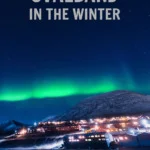People in Svalbard experience several weeks of total darkness during the winter. Here's what to expect if you visit, the top things to do in Svalbard in winter, how to spot Arctic wildlife, and what it’s like to live in the world's northernmost town during the darkest time of year.
Svalbard is an Arctic archipelago halfway between mainland Norway and the North Pole. It’s a land of icy fjords, dramatic mountains, and polar bears. And it's home to the world’s northernmost permanently inhabited settlement, Longyearbyen.
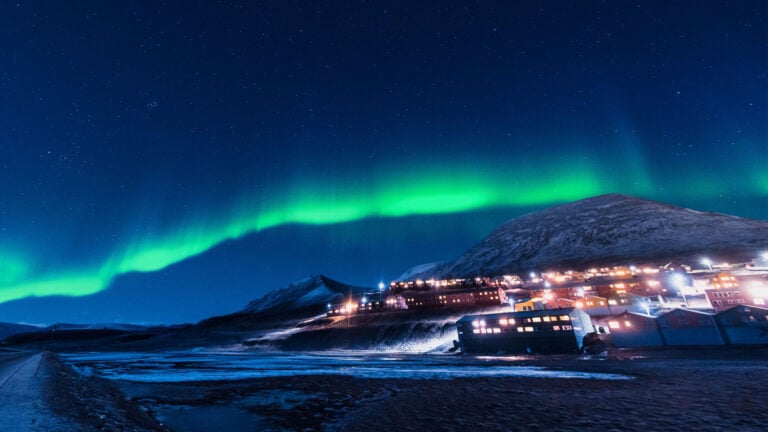
While many visitors head north during summer for the midnight sun or spring for snowmobiling under a blue sky, winter in Svalbard is a dramatically different experience.
The sun doesn’t rise at all for weeks. The landscapes are bathed in moonlight or the soft blue twilight of the polar night. It’s not for everyone. But for the curious and adventurous, Svalbard in winter is unforgettable.
The Polar Night: Darkness Around the Clock
From late October to mid-February, the sun stays below the horizon in Longyearbyen. The peak of the polar night (mid-November to the end of January) brings total darkness 24 hours a day.
But “total darkness” doesn’t always mean pitch black. On completely clear days, a few hours of soft blue light appear on the southern horizon, known locally as the blåtimen, or “blue hour.” On cloudy days, the darkness is indeed total.
Street lights stay on all day, headlamps are essential, and the moon or northern lights often replace the sun. This surreal atmosphere can feel disorienting at first, but it’s a big part of what makes visiting Svalbard in the winter so unique.
Curious about what that is like? So was I! So in December 2021, I packed by bags and headed north for the second time. Check out this video, filmed at 1pm to see just how dark it is in the daytime:
Can you imagine living in those conditions, day by day for weeks at a time? Many people do. Many people also choose to visit at this time of year. Not just me!
Things To Do in Svalbard in the Winter
You might think that 24/7 darkness would limit your activity options, but in fact, there’s a surprising amount to do.
Local tour companies are well-prepared for the polar night, and this time of year offers a raw, immersive Arctic experience. Later in the winter, especially February and March, brings the return of daylight combined with snowy landscapes. It's a very special time to visit.
1. Snowmobile Adventures
Snowmobiling is a way of life in Svalbard, and it’s also one of the most thrilling ways to explore beyond Longyearbyen.
From mid-February onwards, multi-hour and full-day snowmobile safaris run to icy valleys, remote glaciers, and even longer tours to the east coast of Spitsbergen, where polar bear sightings are more likely.
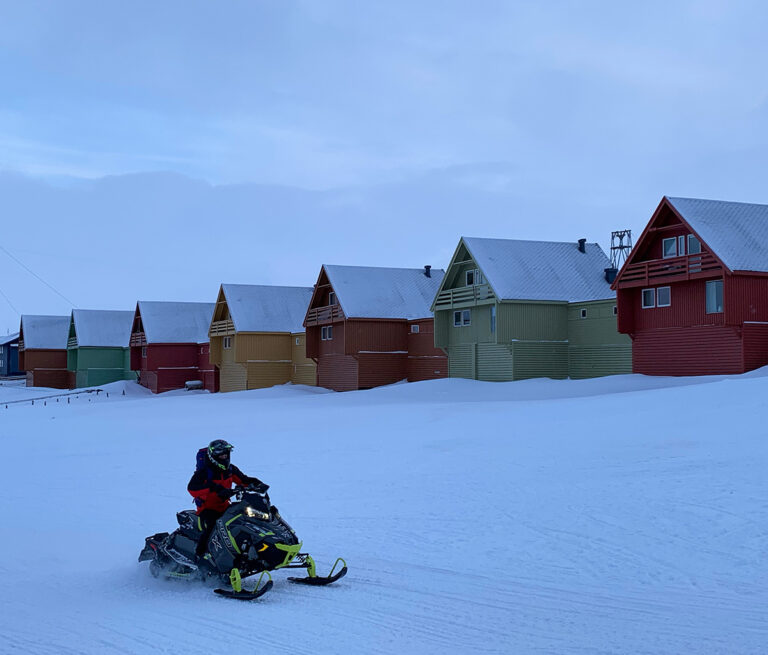
During the polar night (November to January), shorter tours operate in near-total darkness. You’ll be outfitted with thermal suits and powerful headlamps to navigate the frozen terrain. These dark-season snowmobile safaris often include a stop to scan the sky for northern lights.
Tip: Some tours include a visit to the stunning ice cave under the glacier at Larsbreen. Ask about availability when booking.
2. Dog Sledding with Huskies
Dog sledding is a peaceful and traditional way to explore the Arctic wilderness. Local companies offer half-day and full-day sled tours during the winter season, where you can learn to harness and drive your own team of huskies or simply enjoy the ride as a passenger.
Even during the darkest months, tours continue with headlamps, reflective gear, and an extra thermos of coffee or hot chocolate!
Most kennels are located in Adventdalen, a short drive from Longyearbyen. You'll also have a chance to meet the dogs and their handlers, many of whom live year-round in Svalbard.
3. See the Northern Lights at Lunchtime
One of the quirks of Svalbard’s winter is that you can potentially see the aurora borealis in the middle of the day. That’s because of the daytime darkness between mid-November and late January.
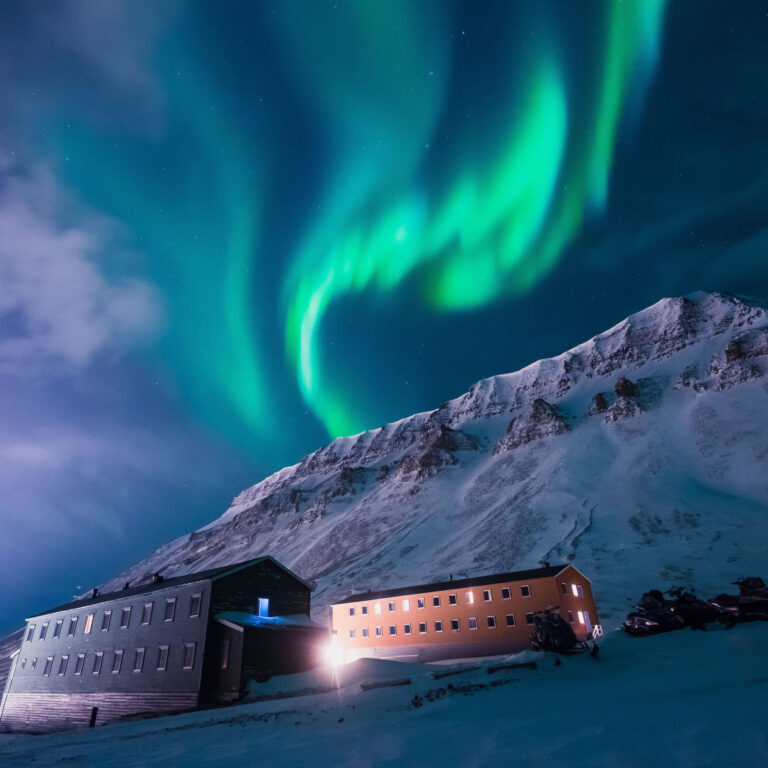
While the lights do tend to be more active at night, midday aurora safaris are possible, especially during periods of strong solar activity.
Longyearbyen has relatively low light pollution, and tour guides know where to go for the best chance of a sighting—often up in the valleys away from town. But remember: seeing the lights is never guaranteed.
4. Ride in a Snowcat
For a slower-paced but equally memorable Arctic journey, hop aboard a snowcat—a large tracked vehicle adapted for winter terrain. These heated rides are ideal for families or anyone wanting to experience the winter wilderness in comfort.
Some evening tours are designed specifically to hunt for the aurora or visit a remote viewpoint with hot drinks served en route.
5. Explore Svalbard’s History at the Museum
Svalbard Museum is an excellent introduction to the archipelago’s past and present. Exhibits cover everything from the whaling era and coal mining to the unique flora and fauna of the high Arctic.
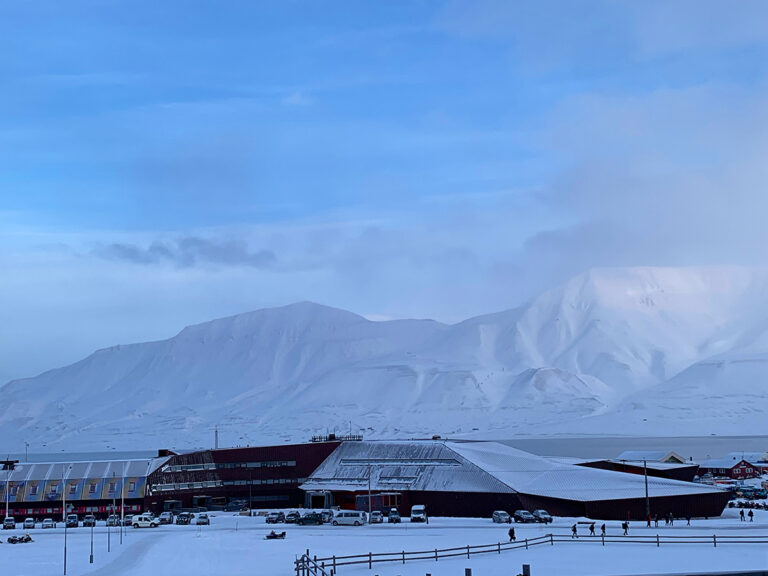
Located in the University building, the museum is a great place to gain perspective on how humans have survived and adapted to life in one of the world’s harshest environments.
Meet the Locals in Longyearbyen
Despite its extreme latitude and Arctic isolation, Longyearbyen is anything but lifeless in the winter. In fact, the darkness seems to draw the community closer together.
Around 2,500 people live here year-round, making it the world’s northernmost town with a permanent population. And what a mix of people it is. There's Norwegians, of course, but also Swedes, Russians, Thais, Filipinos, and a surprising number of Spanish speakers, thanks to academic and tourism connections.
Most residents are here for work or research, often on temporary contracts, but many choose to stay longer than they planned. Ask anyone in town how long they’ve lived here, and you’ll likely get a story that starts with “I was only supposed to stay one season…”
Winter, when there are fewer tourists and the town settles into a slower rhythm, is the perfect time to get a feel for this unique community.
The Heartbeat of Town: Svalbard Church
Perched slightly above the main part of Longyearbyen, Svalbard Church is open 24 hours a day, every day of the year. That in itself tells you something about its importance here.
More than just a place of worship, the church is a social venue for locals and visitors alike. Watch this brief one-minute video for an introduction:
Candlelit during the polar night and warmed by wood-burning stoves, it offers regular Sunday services, of course, but also informal evening gatherings, concerts, and even waffle nights. Everyone is welcome, regardless of religious background.
During winter, many residents find comfort in the calm, warm interior, whether it’s for quiet reflection, conversation over coffee, or simply to sit and enjoy the silence.
Cultural Centre and Library
Longyearbyen punches above its weight when it comes to culture. The Longyearbyen Library and Kulturhus (cultural centre) hosts an impressive range of activities for such a small population. Inside, you’ll find not just books, but art exhibits, lectures, community workshops, and musical performances—even in the depths of winter.
If you happen to visit on a day when a local author or polar historian is giving a talk, go. These events are intimate, casual, and often fascinating windows into life in the high north.
The library also makes a good stop just to warm up and enjoy the view from one of the reading corners.
Café Culture, Arctic-Style
Fruene Café, located in the town centre, is a hub of daily life in Longyearbyen. Equal parts coffee shop, bakery, restaurant, and chocolate boutique, it’s where locals go for everything from a morning latte to the soup of the day.
Try their popular homemade chocolates with polar bear shapes, or their hearty fish soup if you're after a warming meal. Conversations at the next table might range from snowmobile maintenance to climate research, and you’re likely to overhear at least three different languages.
Other local favourites include Café Huskies, which is home to retired sled dogs roaming among patrons, and Stationen, a laid-back bar and restaurant with decent hot food and a great atmosphere.
Taproom Tales at the Northernmost Brewery
Svalbard Bryggeri, the world’s northernmost brewery, isn’t just a fun trivia point—it’s a genuine source of pride for Longyearbyen. Built after a lengthy campaign to change local alcohol laws, the brewery now produces award-winning beer using melted glacier water from the surrounding mountains.
Winter Wildlife in Svalbard
There may not be much daylight, but the wildlife doesn’t disappear. In fact, winter offers a different window into the Arctic ecosystem, if you know what to look for.
Polar Bears
Polar bears are the symbol of Svalbard. While most sightings happen on the more remote east coast, they’re known to roam vast distances, even across the sea ice during winter.
Because of this, anyone leaving Longyearbyen’s town limits must carry a firearm or be accompanied by an armed guide. Tour operators follow strict safety procedures to reduce risk and ensure ethical wildlife viewing.
Polar bear sightings near town are rare but not impossible. If you’re lucky enough to see one from a distance on a tour, it’s likely to be a moment you’ll never forget.
Arctic Fox
The Arctic fox is one of the few mammals to remain active throughout the polar night. Their thick white winter coats camouflage them in the snow, but their curious nature often brings them close to human activity.
You might spot one near the dog kennels, on a snowmobile trail, or even darting through the outskirts of Longyearbyen in search of food.
Svalbard Reindeer
Smaller and stockier than their mainland cousins, the Svalbard reindeer are adapted to survive extreme cold and scarce vegetation. They don’t migrate and are often seen foraging in and around Longyearbyen, even during the darkest months.
Their calm temperament and photogenic appearance make them a popular sight with winter visitors.
Svalbard Rock Ptarmigan
This is the only land bird that stays on the archipelago year-round.
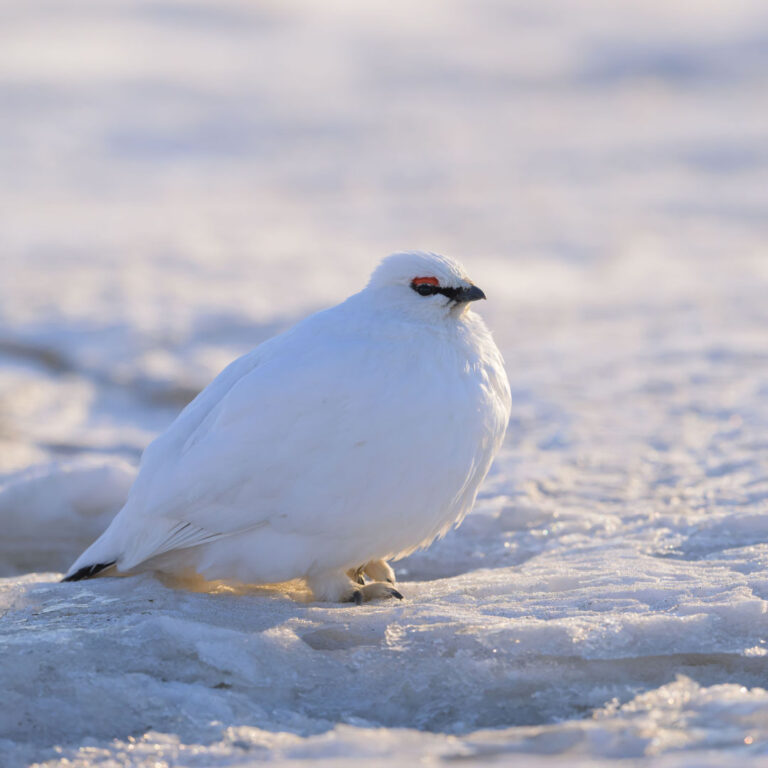
The ptarmigan turns completely white in winter and feeds on twigs and dry grass poking through the snow. Listen for their distinctive croaking calls during quiet walks near the town.
Seabirds and Marine Life
Most bird species migrate south for winter, but a few hardy seabirds, including the long-tailed duck and black guillemot, stick around in ice-free coastal areas.
Walruses and seals also remain in the region, though they’re harder to spot in winter without heading out on an expedition cruise or coastal tour.
What to Pack for a Winter Trip to Svalbard
Packing properly can make or break your trip. Temperatures often fall to -20°C (-4°F) or lower, with wind chill making it feel even colder. Tour operators provide thermal suits and boots for excursions, but you’ll need to bring your own quality base layers.
Winter essentials include:
- Thermal underwear (merino wool is ideal)
- Fleece or down mid-layers
- Windproof and insulated outer layers
- Warm hat, gloves, neck gaiter, and mittens
- Headlamp (with extra batteries!)
- Hand warmers
- Waterproof boots with traction soles
- Power bank for electronics (batteries drain faster in cold)
Weather & Daylight: What to Expect Month-by-Month
| Month | Daylight | Typical Conditions |
| November | Polar night begins | Temperatures falling, first snows |
| December | 24h darkness | Coldest period, stunning auroras |
| January | Still no sunrise | Slightly lighter skies return |
| February | Sun returns mid-month | More tours available, snowmobiling season ramps up |
| March | Bright snowy days | Great conditions for longer trips |
Getting to Svalbard in the Winter
Svalbard is accessible year-round by plane from Oslo and Tromsø. Flights are more limited in winter, and weather-related delays are not uncommon.
Both SAS and Norwegian operate direct flights to Longyearbyen (LYR). There are no roads between settlements, and cruise ships only sail in summer, so winter visitors should plan to stay in or near Longyearbyen.
Living Through Winter in Svalbard
To truly understand Svalbard in the winter, you need to talk to the people who call it home.
In my interview with Svalbard-based researcher Peter Betlem, he said the darkest season isn’t necessarily the hardest part: “It’s actually the transition between light and dark that’s most difficult, because the change is so rapid.”
Peter also emphasised the extremes of life in Longyearbyen: “We have the luxuries of Europe—daily post, supermarkets, decent wine—but it’s still the Arctic. Someone was killed by a polar bear recently just outside town. That balance between comfort and danger is the most striking thing about life here.”
Is Winter in Svalbard for You?
Visiting Svalbard in winter isn’t for everyone. And that's even more true in the winter. It’s cold, it’s dark, and it’s remote. But it’s also magical.
Whether you're watching the aurora shimmer over snowy peaks, gliding through the silence behind a team of huskies, or sharing a drink with locals at the world’s northernmost pub, this is the kind of place that changes your perspective.
Have you visited Svalbard during the winter? How was your experience? Let us know in the comments below.

